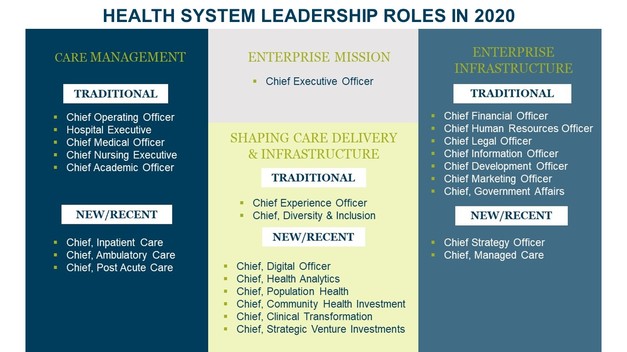Health care organizations are increasingly moving away from hospital-based, inpatient care to community-based models that focus on prevention and sustaining well-being – as well as meeting the social needs of vulnerable patients. Specific approaches vary at health systems across the country but are, in some cases, paving the way for new leadership roles.
New C-suite positions include, but are not limited to, population health executive, chief digital officer, chief clinical transformation officer, chief health analytics officer, and chief community health investment officer. Many of these roles have emerged in response to changes in health care delivery.
“The chief community health investment officer role is one of the most exciting additions to the C-suite since it aligns health care and social services resources in a powerful new way,” says Dan Carney, a health care practice partner at executive search firm DHR. “Yet, it’s only one of 25 new and traditional roles our practice colleagues have identified that are shaping health care delivery.”
Social Needs Drive New Strategies
“Traditionally, the only way hospitals interacted with patients is when they became sick,” says Dr. Ram Raju, senior vice president and the community health investment officer at Northwell Health in New York. “We’re looking at how we move from sick care to a total health system where we look at health holistically, from social and spiritual needs to financial and educational needsorthwell Health works to improve the health outcomes of people in its most vulnerable communities, coordinating efforts with community organizations, nonprofit groups and public-private partners. The organization created a 15-question social risk assessment and scoring index that enables hospital staff to assign patients to needed services quickly. In addition, Northwell Health connects patients to community-based resources seamlessly through a shared computer network.
“Hospitals usually look at clinical risk, such as whether someone could develop diabetes or high blood pressure,” Raju says. “We’re creating a social risk index for factors such as whether someone lives in an unsafe area, can’t afford co-pays and prescription drugs, and lacks transportation. We can measure social risk objectively and see how reducing that risk improves health outcomes.”
Raju’s focus on meeting patients’ social needs, such as food security, housing instability and lack of transportation, means he seeks passionate leaders who are dedicated to serving the community and educating patients.
“This is not easy work,” he says. “We look for people who are charismatic, have high emotional intelligence, are able to deal with different patient populations effectively, and are community change agents.”

What the Future Holds
Henry Ford Health System has a population health executive and a chief health analytics officer. It’s also considering adding a chief digital officer, a senior leadership role that would develop new online, mobile and digital tools to drive innovation.
“With all the evolution in health care, we’re looking at how we reimagine the care experience across the system – not just when an individual happens to be a patient,” says Wright Lassiter III, president and CEO of the Detroit-based organization.
The end-to-end approach even led Henry Ford Health System to team up with postal workers to help with community outreach.
As health systems adopt new initiatives to improve the quality of care and patient outcomes, the C-suite will likely continue to evolve. Conversations among future leaders will also change.
“Historically, the conversations have been around filling beds, monitoring inpatient activities and ensuring our assets are full and busy,” Lassiter says. “I think we’ll be talking more about the investments we need to make today to manage costs and quality more effectively.
“We’ll also be looking at how to drive revenue to cover the fixed expenses of a hospital operating company,” he says. “Another topic will be the strategic partnerships that will be needed to manage the new health care economy.”
The Larger Trend
New hospital leadership roles are opening up across the U.S. While their specific responsibilities vary from organization to organization, they’re on point to expand in the future. Whether these executives focus on innovation and digital strategy, population health management, community partnerships, accountability or quality improvement, they have at least one goal in common: top performance.
“The past decade has seen dramatic changes in the delivery of patient care,” Carney says. “New roles are bringing new skill sets and traditional roles are evolving as new skills are required to improve performance. At DHR, we’re excited to support our clients by finding the ideal individuals for these roles, bringing career growth opportunities to candidates, and, ultimately, advancing patients’ health and well-being.”
